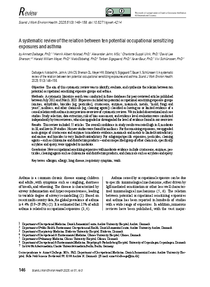A systematic review of the relation between ten potential occupational sensitizing exposures and asthma

Dalbøge, A ; Kolstad, H.A. ; Jahn, Andreas ; Ulrik, C.S. ; Sherson, D.L. ; Meyer, H.W. ; Ebbehoj, Niels ; Sigsgaard, T. ; Baur, Xaver ; Schlünssen, Vivi
Scandinavian Journal of Work, Environment and Health
2025
51
3
146-158
asthma ; sensitizers ; exposure assessment
Occupational risks
https://doi.org/10.5271/sjweh.4214
English
Bibliogr.
"Objective
The aim of this systematic review was to identify, evaluate, and synthesize the relation between ten potential occupational sensitizing exposure groups and asthma.
Methods
A systematic literature search was conducted in three databases for peer-reviewed articles published between July 2011 and March 2023. Exposures included ten potential occupational sensitizing exposure groups (amines, anhydrides, biocides [eg, pesticides], crustaceans, enzymes, mammals, metals, “mold, fungi and yeast”, molluscs, and other chemicals [eg, cleaning agents]) classified as having no or limited evidence of a causal relation with asthma in our previous overview of systematic reviews. We included observational and case studies. Study selection, data extraction, risk of bias assessment, and evidence level evaluation were conducted independently by two reviewers, who also upgraded or downgraded the level of evidence found in our overview.
Results
This review included 55 articles. The overall confidence in study results was rated high in 8, moderate in 18, and low in 29 studies. No new studies were found for molluscs. For the remaining exposures, we upgraded main groups of crustaceans and enzymes to moderate evidence, mammals and metals to limited/contradictory, and amines and biocides to very limited/contradictory. For subgroups/specific exposures, pesticides, cleaning agents – such as chloramine and disinfection products – and an unspecified group of other chemicals, specifically acrylates and epoxy, were upgraded to moderate.
Conclusion
New occupational sensitizing exposures with moderate evidence include crustaceans, enzymes, pesticides, cleaning agents such as chloramine and disinfection products, and chemicals such as acrylates and epoxy."
This work is licensed under a Creative Commons Attribution 4.0 International License.
Digital
The ETUI is co-funded by the European Union. Views and opinions expressed are however those of the author(s) only and do not necessarily reflect those of the European Union or the ETUI.